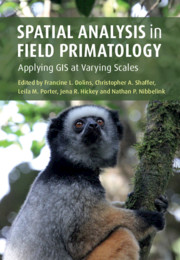'… the editors provide an excellent primer on GPS and GIS fundamentals that deftly expands to include research findings using more advanced methods. This resource covers applications of GPS and GIS directly relevant to readers from many areas of conservation biology who already use or want to use telemetry, GPS, or GIS analysis. This reviewer recommends the volume to any interested reader: it is not just for primatologists and will be an excellent reference for all researchers and students with biogeography, wildlife management, or technical GIS interests. Highly recommended.'
C. A. Badurek
Source: Choice
‘… the editors of this book have done an admirable job bringing together and synthesizing a wide range of analytic methods and topics involving spatial data. This volume will serve as an excellent reference for anyone interested in spatial analyses.’
Sarie Van Belle
Source: Quarterly Review of Biology
‘Spatial Analysis in Field Primatology: Applying GIS at Varying Scales is the first integrated guide outlining the best practices in GPS or applying GIS to research questions specific to primatology, thus filling a gap in the methodological literature. It is an engaging and compelling read; in 20 chapters encompassing literature reviews and empirical studies, it comprehensively instructs the reader in how specific methods and technologies can be applied to broaden our understanding of the spatial aspects of primate behavioral and population ecology. A great addition to the burgeoning field of GPS and GIS within primatology, I highly recommend it for early- to mid-career primatologists and research groups who can apply the information to their own investigations about species' behavior, ecological knowledge, and conservation. It can also potentially be a valuable resource for a wider audience including postgraduate or advanced undergraduate classes geared toward methods in field primatology, in addition to senior groups looking to analyze existing data in new ways. The clear research priorities and future directions laid out in the text will stimulate such researchers to overcome the practical issues currently experienced, contribute to primate conservation, and advance the field more rapidly in a way that is appropriate, accurate, and ethical.’
Lauren Wiseman-Jones
Source: American Journal of Physical Anthropology
‘Some chapters provide a good entry point to spatial analysis in field primatology, while other chapters are more advanced. All of them will leave you curious to dig deeper into the literature. The quality of the writing (and of the conceptual content) is very high throughout: the individual authors and editors are to be commended for putting together an authoritative volume that successfully captures the essential nature of GIS use by primatologists at the beginning of the 21st century.’
Amanda Suzzi
Source: Evolutionary Anthropology
'… the editors provide an excellent primer on GPS and GIS fundamentals that deftly expands to include research findings using more advanced methods. This resource covers applications of GPS and GIS directly relevant to readers from many areas of conservation biology who already use or want to use telemetry, GPS, or GIS analysis. This reviewer recommends the volume to any interested reader: it is not just for primatologists and will be an excellent reference for all researchers and students with biogeography, wildlife management, or technical GIS interests. Highly recommended.'
C.A. Badurek
Source: Choice



